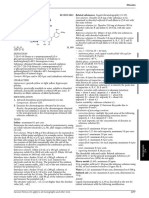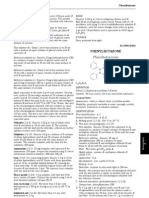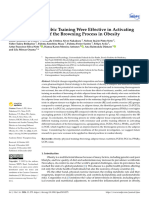Ep 8.0
Ep 8.0
Uploaded by
Duyên PhạmCopyright:
Available Formats
Ep 8.0
Ep 8.0
Uploaded by
Duyên PhạmOriginal Title
Copyright
Available Formats
Share this document
Did you find this document useful?
Is this content inappropriate?
Copyright:
Available Formats
Ep 8.0
Ep 8.0
Uploaded by
Duyên PhạmCopyright:
Available Formats
Diosmin EUROPEAN PHARMACOPOEIA 8.
the contents of the flask immediately after the end of the
combustion to dissolve completely the combustion products.
Continue stirring for 1 h.
Reference solution. Dilute 2.0 mL of a 16.6 g/L solution of
potassium iodide R to 100.0 mL with water R. Dilute 10.0 mL
E. (Z)-7-[2-[(E)-(3S)-3-hydroxyoct-1-enyl]-5-oxocyclopent- of the solution to 100.0 mL with water R.
1-enyl]hept-5-enoic acid (PGB2), Introduce into a beaker 30 mL of a 200 g/L solution of
potassium nitrate R in 0.1 M nitric acid. Immerse the
electrodes and stir for 10 min. The potential of the solution
(nT1) must remain stable. Add 1 mL of the test solution and
measure the potential (nT2).
Introduce into a beaker 30 mL of a 200 g/L solution of
potassium nitrate R in 0.1 M nitric acid. Immerse the
F. (Z)-7-[(1R,2R,3R)-3-hydroxy-2-[(E)-3-oxo-oct-1-enyl]- electrodes and stir for 10 min. The potential of the solution
5-oxocyclopentyl]hept-5-enoic acid (15-oxo-PGE2 ; must remain stable (nR1). Add 80 μL of the reference solution
15-keto-PGE2). and measure the potential (nR2).
The absolute value |nT2 - nT1| is not higher than the absolute
01/2008:1611 value |nR2 - nR1|.
Related substances. Liquid chromatography (2.2.29).
DIOSMIN Test solution. Dissolve 25.0 mg of the substance to be
examined in dimethyl sulfoxide R and dilute to 25.0 mL with
the same solvent.
Diosminum
Reference solution (a). Dissolve 25.0 mg of diosmin CRS in
dimethyl sulfoxide R and dilute to 25.0 mL with the same
solvent.
Reference solution (b). Dilute 5.0 mL of reference solution (a)
to 100.0 mL with dimethyl sulfoxide R.
Reference solution (c). Dissolve 5.0 mg of diosmin for system
suitability CRS in dimethyl sulfoxide R and dilute to 5.0 mL
with the same solvent.
C28H32O15 Mr 609 Column :
[520-27-4] – size : l = 0.10 m, Ø = 4.6 mm,
DEFINITION – stationary phase : octadecylsilyl silica gel for
chromatography R (3 μm),
7-[[6-O-(6-Deoxy-α-L-mannopyranosyl)-β-D-
glucopyranosyl]oxy]-5-hydroxy-2-(3-hydroxy-4- – temperature : 40 °C.
methoxyphenyl)-4H-1-benzopyran-4-one. Mobile phase : acetonitrile R, glacial acetic acid R, methanol R,
Substance obtained through iodine-assisted oxidation water R (2:6:28:66 V/V/V/V).
of (2S)-7-[[6-O-(6-deoxy-α-L-mannopyranosyl)-β- Flow rate : 1.5 mL/min.
D-glucopyranosyl]oxy]-5-hydroxy-2-(3-hydroxy-4- Detection : spectrophotometer at 275 nm.
methoxyphenyl)-2,3-dihydro-4H-1-benzopyran-4-one Injection : 10 μL loop injector ; inject the test solution and
(hesperidin) of natural origin. reference solutions (b) and (c).
Content : 90.0 per cent to 102.0 per cent (anhydrous substance). Run time : 6 times the retention time of diosmin.
CHARACTERS Relative retention with reference to diosmin (retention
Appearance : greyish-yellow or light yellow hygroscopic time = about 4.6 min) : impurity A = about 0.5,
powder. impurity B = about 0.6, impurity C = about 0.8,
impurity D = about 2.2, impurity E = about 2.6,
Solubility : practically insoluble in water, soluble in dimethyl impurity F = about 4.5.
sulfoxide, practically insoluble in alcohol. It dissolves in dilute
solutions of alkali hydroxides. System suitability : reference solution (c) :
– resolution : minimum of 2.5 between the peaks due to
IDENTIFICATION impurities B and C.
A. Infrared absorption spectrophotometry (2.2.24). Limits :
Comparison : diosmin CRS. – correction factors : for the calculation of contents,
B. Examine the chromatograms obtained in the assay. multiply the peak areas of the following impurities by
Results : the principal peak in the chromatogram obtained the corresponding correction factor : impurity A = 0.38 ;
with the test solution is similar in retention time and size impurity F = 0.61,
to the principal peak in the chromatogram obtained with – impurity A : not more than 0.2 times the area of the
reference solution (a). principal peak in the chromatogram obtained with
reference solution (b) (1 per cent),
TESTS – impurity B : not more than the area of the principal peak
Iodine : maximum 0.1 per cent. in the chromatogram obtained with reference solution (b)
Determine the total content of iodine by potentiometry, using (5 per cent),
an iodide-selective electrode (2.2.36), after oxygen combustion – impurity C : not more than 0.6 times the area of the
(2.5.10). principal peak in the chromatogram obtained with
Test solution. Wrap 0.100 g of the substance to be examined in reference solution (b) (3 per cent),
a piece of filter paper and place it in a sample carrier. Introduce – impurity E : not more than 0.6 times the area of the
into the flask 50 mL of a 0.2 g/L solution of hydrazine R. Flush principal peak in the chromatogram obtained with
the flask with oxygen for 10 min. Ignite the filter paper. Stir reference solution (b) (3 per cent),
2072 See the information section on general monographs (cover pages)
EUROPEAN PHARMACOPOEIA 8.0 Diphenhydramine hydrochloride
– impurity F : not more than 0.6 times the area of the principal
peak in the chromatogram obtained with reference
solution (b) (3 per cent),
– any other impurity : not more than 0.2 times the area of
the principal peak in the chromatogram obtained with
reference solution (b) (1 per cent),
– total of other impurities and impurity A : not more than
0.2 times the area of the principal peak in the chromatogram F. 5,7-dihydroxy-2-(3-hydroxy-4-methoxyphenyl)-4H-1-
obtained with reference solution (b) (1 per cent), benzopyran-4-one (diosmetin).
– total : not more than twice the area of the principal peak
in the chromatogram obtained with reference solution (b) 01/2008:0023
(10 per cent), corrected 6.0
– disregard limit : 0.02 times the area of the principal peak
in the chromatogram obtained with reference solution (b)
(0.1 per cent).
DIPHENHYDRAMINE
Heavy metals (2.4.8) : maximum 20 ppm.
HYDROCHLORIDE
2.0 g complies with test C. Prepare the reference solution using
4.0 mL of lead standard solution (10 ppm Pb) R. Diphenhydramini hydrochloridum
Water (2.5.12) : maximum 6.0 per cent, determined on 0.300 g.
Sulfated ash (2.4.14) : maximum 0.2 per cent, determined on
1.0 g.
ASSAY
Liquid chromatography (2.2.29), as described in the test for
related substances.
C17H22ClNO Mr 291.8
Injection : test solution and reference solution (a). [147-24-0]
STORAGE DEFINITION
In an airtight container. 2-(Diphenylmethoxy)-N,N-dimethylethanamine
IMPURITIES hydrochloride.
Content : 99.0 per cent to 101.0 per cent (dried substance).
CHARACTERS
Appearance : white or almost white, crystalline powder.
Solubility : very soluble in water, freely soluble in alcohol.
IDENTIFICATION
A. 1-(3-hydroxy-4-methoxyphenyl)ethanone
(acetoisovanillone), First identification : C, D.
Second identification : A, B, D.
A. Melting point (2.2.14) : 168 °C to 172 °C.
B. Dissolve 50 mg in alcohol R and dilute to 100.0 mL with
the same solvent. Examined between 230 nm and 350 nm,
the solution shows 3 absorption maxima (2.2.25), at
253 nm, 258 nm and 264 nm. The ratio of the absorbance
measured at the maximum at 258 nm to that measured
at the maximum at 253 nm is 1.1 to 1.3. The ratio of the
B. (2S)-7-[[6-O-(6-deoxy-α-L-mannopyranosyl)-β-D- absorbance measured at the maximum at 258 nm to that
glucopyranosyl]oxy]-5-hydroxy-2-(3-hydroxy-4- measured at the maximum at 264 nm is 1.2 to 1.4.
methoxyphenyl)-2,3-dihydro-4H-1-benzopyran-4-one C. Infrared absorption spectrophotometry (2.2.24).
(hesperidin),
Preparation : discs.
Comparison : diphenhydramine hydrochloride CRS.
D. It gives the reactions of chlorides (2.3.1).
TESTS
Solution S. Dissolve 1.0 g in carbon dioxide-free water R and
dilute to 20 mL with the same solvent.
Appearance of solution. Solution S and a fivefold dilution of
C. R1 = R3 = H, R2 = OH : 7-[[6-O-(6-deoxy-α-L- solution S are clear (2.2.1). Solution S is not more intensely
mannopyranosyl)-β-D-glucopyranosyl]oxy]-5-hydroxy-2- coloured than reference solution BY6 (2.2.2, Method II).
(4-hydroxyphenyl)-4H-1-benzopyran-4-one (isorhoifolin),
Acidity or alkalinity. To 10 mL of solution S add 0.15 mL of
D. R1 = OH, R2 = OCH3, R3 = I : 7-[[6-O-(6-deoxy-α-L- methyl red solution R and 0.25 mL of 0.01 M hydrochloric acid.
mannopyranosyl)-β-D-glucopyranosyl]oxy]-5-hydroxy-2- The solution is pink. Not more than 0.5 mL of 0.01 M sodium
(3-hydroxy-4-methoxyphenyl)-6-iodo-4H-1-benzopyran- hydroxide is required to change the colour of the indicator
4-one (6-iododiosmin), to yellow.
E. R1 = R3 = H, R2 = OCH3 : 7-[[6-O-(6-deoxy-α-L- Related substances. Liquid chromatography (2.2.29).
mannopyranosyl)-β-D-glucopyranosyl]oxy]-5-hydroxy-2- Test solution. Dissolve 70 mg of the substance to be examined
(4-methoxyphenyl)-4H-1-benzopyran-4-one (linarin), in the mobile phase and dilute to 20.0 mL with the mobile
General Notices (1) apply to all monographs and other texts 2073
You might also like
- TEMPLATE - Odoo Offer For PartnersDocument37 pagesTEMPLATE - Odoo Offer For Partnersjoel nugrohoNo ratings yet
- Kioti Daedong NX4510 (C) (H) (CH), NX5010 (C) (H) (CH), NX5510 (C) (H) (CH), NX6010H (CH) Tractors Service ManaulDocument19 pagesKioti Daedong NX4510 (C) (H) (CH), NX5010 (C) (H) (CH), NX5510 (C) (H) (CH), NX6010H (CH) Tractors Service ManaulLisakolyNo ratings yet
- 1611 - DiosminaDocument2 pages1611 - DiosminaGrenfell VPKNo ratings yet
- Ambroxol hydrochlorideDocument2 pagesAmbroxol hydrochloridephu DuongNo ratings yet
- Propyl ParahydroxybenzoateDocument2 pagesPropyl ParahydroxybenzoateNam NguyenNo ratings yet
- Amisulpride EP 11.0Document2 pagesAmisulpride EP 11.0noschNo ratings yet
- Apomorphine Hydrochloride HemihydrateDocument2 pagesApomorphine Hydrochloride HemihydrateNguyen Van ThaoNo ratings yet
- ZopicloneDocument2 pagesZopicloneaymenbiogalenicNo ratings yet
- Sulpiride MonographieDocument3 pagesSulpiride MonographieMohamed DahmaneNo ratings yet
- Diosmin (1611)Document2 pagesDiosmin (1611)Mulayam Singh Yadav100% (1)
- Xylometazoline HydrochlorideDocument2 pagesXylometazoline HydrochlorideaymenbiogalenicNo ratings yet
- DexpanthenolDocument2 pagesDexpanthenolHamza MaverickNo ratings yet
- Ep7.0 02 1504Document2 pagesEp7.0 02 1504Sidahmed SiDo BouchenakNo ratings yet
- AdrenalineDocument2 pagesAdrenalinehailagarciaramirez8No ratings yet
- Quinine Hydrochloride 0018eDocument2 pagesQuinine Hydrochloride 0018eMark GoldbergNo ratings yet
- Acid AscorbicDocument2 pagesAcid AscorbicIli MarinaNo ratings yet
- ZidovudineDocument3 pagesZidovudineaymenbiogalenicNo ratings yet
- BarbitalDocument2 pagesBarbitalOrlando David Medinueta De AvilaNo ratings yet
- Piperacillin sodiumDocument4 pagesPiperacillin sodiumHung QuangNo ratings yet
- Dopamine Hydrochloride 0664eDocument2 pagesDopamine Hydrochloride 0664ejen10132002No ratings yet
- 1950-1951Document2 pages1950-1951gapanalysis23No ratings yet
- NimesulideDocument2 pagesNimesulideHPLC E77 Quality FarmaNo ratings yet
- Esomeprazole Magnesium Dihydrate EP 11.0Document3 pagesEsomeprazole Magnesium Dihydrate EP 11.0noschNo ratings yet
- GLUTATION Farmacopea EuropeaDocument3 pagesGLUTATION Farmacopea Europeaafuselli.lipomizeNo ratings yet
- Sodium Hydrogen Chloride EPDocument2 pagesSodium Hydrogen Chloride EPASHOK KUMAR LENKANo ratings yet
- DexpanthenolDocument2 pagesDexpanthenolArtem KulikovNo ratings yet
- Isoprenaline HydrochlorideDocument2 pagesIsoprenaline HydrochloridesofianesedkaouiNo ratings yet
- Arginine AspartateDocument2 pagesArginine AspartateNguyen Van ThaoNo ratings yet
- PHE MonographieDocument3 pagesPHE Monographiebalkis hciniNo ratings yet
- VoriconazoleDocument2 pagesVoriconazoleaymenbiogalenicNo ratings yet
- 2,4 Dichlorobenzyl AlcoholDocument2 pages2,4 Dichlorobenzyl AlcoholsamanehNo ratings yet
- PhenylbutazoneDocument3 pagesPhenylbutazoneThiago FerreiraNo ratings yet
- Doxorubicin HydrochlorideDocument2 pagesDoxorubicin Hydrochlorideflaavb100% (1)
- Xylazine Hydrochloride For Veterinary UseDocument2 pagesXylazine Hydrochloride For Veterinary UseaymenbiogalenicNo ratings yet
- Oxacillin Sodium MonohydrateDocument3 pagesOxacillin Sodium Monohydrateluuvantrung1989No ratings yet
- Cetirizine DihydrochlorideDocument3 pagesCetirizine DihydrochloridePRADIKA HANDIWIANTANo ratings yet
- Felodipine: FelodipinumDocument2 pagesFelodipine: FelodipinumIoana-Alexandra Lungu-NastaseNo ratings yet
- DIPROPHYLLINEDocument2 pagesDIPROPHYLLINEmononoketangqihotmail.comNo ratings yet
- SORBITOLDocument2 pagesSORBITOLUrsula Rodrigues CabralNo ratings yet
- Isoxsuprine HydrochlorideDocument2 pagesIsoxsuprine HydrochlorideYuli HdyNo ratings yet
- CBD PH - Eur MonographDocument3 pagesCBD PH - Eur MonographCecilia MonroyNo ratings yet
- Fosfomycin EP PDFDocument2 pagesFosfomycin EP PDFASHOK KUMAR LENKA100% (2)
- Fosfomycin EPDocument2 pagesFosfomycin EPASHOK KUMAR LENKANo ratings yet
- Mannitol 0559eDocument2 pagesMannitol 0559eRajesh RaviNo ratings yet
- Cefotaxime Sodium Eur - PHDocument3 pagesCefotaxime Sodium Eur - PHinha_azzahRaNo ratings yet
- XylitolDocument3 pagesXylitolTiago Luiz Tortella100% (1)
- Zuclopenthixol DecanoateDocument2 pagesZuclopenthixol DecanoateaymenbiogalenicNo ratings yet
- Ambroxol Hydrochloride: Ambroxoli HydrochloridumDocument2 pagesAmbroxol Hydrochloride: Ambroxoli HydrochloridumANDERSON MNo ratings yet
- IsoniazidDocument1 pageIsoniazidChowdhury Faiz HossainNo ratings yet
- Bromhexine HydrochlorideDocument2 pagesBromhexine HydrochlorideOrlando David Medinueta De AvilaNo ratings yet
- Enalapril Maleate EP 11.0Document3 pagesEnalapril Maleate EP 11.0noschNo ratings yet
- Tramadol HydrochlorideDocument2 pagesTramadol HydrochlorideNurFauziahKasimNo ratings yet
- Ethanol (96 Per Cent)Document3 pagesEthanol (96 Per Cent)drfatimababurNo ratings yet
- Nitric AcidDocument2 pagesNitric AcidAlexi Del Castillo MustaineNo ratings yet
- Enrofloxacin For Veterinary UseDocument3 pagesEnrofloxacin For Veterinary Usenguyentuanson167No ratings yet
- Flow Rate: 1.0 Ml/min. Detection: Spectrophotometer at 230 Nm. Injection: 5 L. System Suitability: Reference Solution (A)Document2 pagesFlow Rate: 1.0 Ml/min. Detection: Spectrophotometer at 230 Nm. Injection: 5 L. System Suitability: Reference Solution (A)lee yongqingNo ratings yet
- AciclovirDocument2 pagesAciclovirTina BasarNo ratings yet
- Esomeprazole Sodium EP 11.0Document2 pagesEsomeprazole Sodium EP 11.0nosch0% (1)
- CHLORTALIDONEDocument2 pagesCHLORTALIDONEartemNo ratings yet
- Advanced Pharmaceutical analysisFrom EverandAdvanced Pharmaceutical analysisRating: 4.5 out of 5 stars4.5/5 (2)
- An Context-Aware Management and Control Mechanism in A MobileDocument12 pagesAn Context-Aware Management and Control Mechanism in A MobilePrasath SivaSubramanianNo ratings yet
- RajatDocument83 pagesRajatrajatkattimani100% (1)
- PMP 450 Series Configuration Guide System Release 22.0Document681 pagesPMP 450 Series Configuration Guide System Release 22.0lachlan johnstonNo ratings yet
- Prace 1Document2 pagesPrace 1TedNo ratings yet
- V - Barter ExchangeDocument16 pagesV - Barter ExchangeAbhinav AgrawalNo ratings yet
- Lab Assignment 5Document9 pagesLab Assignment 5Shivam PandeyNo ratings yet
- Cable TSJ y TSJ-N PDFDocument4 pagesCable TSJ y TSJ-N PDFmakv12100% (2)
- Guia de Docència I Aula Global - en PDFDocument15 pagesGuia de Docència I Aula Global - en PDFAshimaSinghNo ratings yet
- AVIROM PLUS - European Retail Park DevaDocument15 pagesAVIROM PLUS - European Retail Park DevaCosmin JoitoiuNo ratings yet
- BCP56T Series: 1. Product ProfileDocument16 pagesBCP56T Series: 1. Product ProfilerolandseNo ratings yet
- The Water Cycle Lesson PlanDocument6 pagesThe Water Cycle Lesson Planapi-424169726No ratings yet
- DNA Methylation Age Analysis of Rapamycin in Common MarmosetsDocument13 pagesDNA Methylation Age Analysis of Rapamycin in Common Marmosetsender000No ratings yet
- Stats 1 Week 6 EMQ SolsDocument4 pagesStats 1 Week 6 EMQ SolsRaju Kaliperumal100% (2)
- Straumann Basic Information On The Prosthetc ProceduresDocument153 pagesStraumann Basic Information On The Prosthetc ProceduresLord_of_InternetNo ratings yet
- Doucr SavDocument2 pagesDoucr SavSurajit SantaveesukNo ratings yet
- ALM Series: Fiber Assurance Solution For Lean OperationsDocument2 pagesALM Series: Fiber Assurance Solution For Lean OperationsJose QuicañoNo ratings yet
- Pontes Et Al., 2023Document14 pagesPontes Et Al., 2023Líh PontesNo ratings yet
- Single User, Multi-User and Network Os, Izuchukwu Nwankpa, 2019516015PBDocument8 pagesSingle User, Multi-User and Network Os, Izuchukwu Nwankpa, 2019516015PBnwankpa izuchukwu victorNo ratings yet
- Birkenstock v. Philippine Shoe Expo Marketing CorporationDocument2 pagesBirkenstock v. Philippine Shoe Expo Marketing CorporationSJ San JuanNo ratings yet
- ARM11Document8 pagesARM11Joseph JohnNo ratings yet
- F.Y.B.Com SyllabusDocument50 pagesF.Y.B.Com Syllabusrakesh_crcNo ratings yet
- Luxury Thesis PDFDocument8 pagesLuxury Thesis PDFveronicarogerskansascity100% (1)
- An Image Reject MixerDocument4 pagesAn Image Reject MixerSerpent DaveNo ratings yet
- Social Issue (World History)Document2 pagesSocial Issue (World History)HaKaHiNaNo ratings yet
- Application of Heat and Cool in Biology-Lozano, Nerizza Anne Q.Document16 pagesApplication of Heat and Cool in Biology-Lozano, Nerizza Anne Q.Nerizza Anne Q. LozanoNo ratings yet
- 13 Thjan 20200Document229 pages13 Thjan 20200Mokarrom Hossain100% (1)
- 8 Post Class Quiz AnswersDocument8 pages8 Post Class Quiz AnswersRuppee EdwardNo ratings yet
- Cry of Pugadlawin: Excalibur Ray V. PalaciosDocument12 pagesCry of Pugadlawin: Excalibur Ray V. PalaciosAngelica Jasmin MagbanuaNo ratings yet

























































































